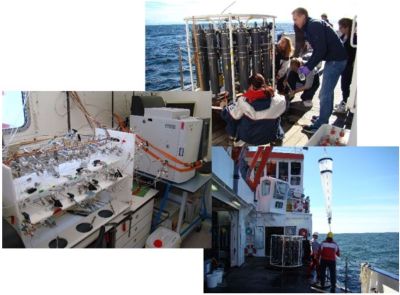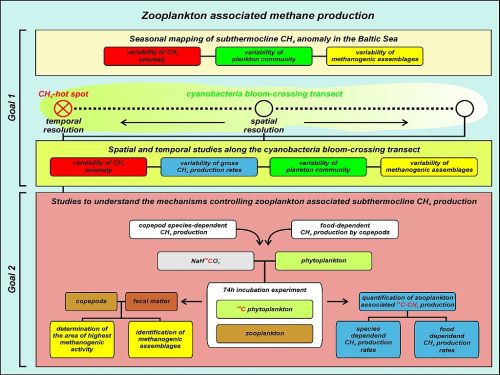
Preliminary Results
In the eastern part of Gotland Basin, central Baltic Sea, methane concentrations just below the thermocline varied between 15 nM and 77 nM, in contrast to the western part where no methane enrichments could be detected. Stable carbon isotope ratios of methane (d13C-CH4 of -67.6 ‰) indicated its in situ biogenic origin from CO2 reduction, which was supported by clonal sequences that clustered with Methanomicrobiaceae, a family of methanogenic Archaea. Incubation experiments with a Temora longicornis dominated seston fraction obtained from the relevant depth showed a positive correlation between seston concentration and methane production rates. Our results, in combination with previous literature outcomes, suggest that the methane enrichment in the eastern basin might be sustained by a diet-consumer relationship between the dinoflagellate Dinophysis norvegica and the copepod T. longicornis. However, our mass balance indicates that a local methane production of 110 pmol L-1 d-1 was needed to maintain the methane enrichment, and that the estimated production rate from our incubation experiments of 0.3 pmol CH4 d-1 per adult T. longicornis (about 1 pmol L-1 d-1) was too low to maintain the methane enrichment by zooplankton associated methane production only. These calculations also showed that methane was consumed below the thermocline and not transported into the upper-ocean, suggesting that other sources in the mixed layer in the range of 95 pmol L-1 d-1 are needed to maintain the observed methane air–sea flux.

Field work on RV Alkor in the central Baltic Sea in summer 2016. Top: water sampling. Right: purge and trap system to measure methane production rates by zooplankton. Left: zooplankton sampling.
The microbiological investigations are coordinated by Priv. Doz. Dr. Matthias Labrenz (IOW), the zooplankton studies are supported by Dr. Natalie Loick-Wilde (IOW), the biomarker studies were carried out by Prof. Dr. Volker Thiel (Geobiology Group, Geoscience Centre, Georg-August-University Göttingen, Germany) and the gas chemistry is coordinated by Dr. Oliver Schmale (IOW). Dr. Beate Stawiarski and Dr. Janine Wäge are the postdocs working in this project at the IOW.
Related publications:
Stawiarski B., Otto S., Thiel V., Gräwe U., Loick-Wilde N., Wittenborn A.K., Schloemer S., Wäge J., Rehder G., Labrenz M., Wasmund N., and Schmale O. (2019). Controls on zooplankton methane production in the central Baltic Sea. Biogeosciences, 16, 1-16.
Wäge J., Strassert J.F.H, Landsberger A., Loick-Wilde N, Schmale O., Stawiarski B., Kreikemeyer B., Michel G. and Labrenz M. (2019). Microcapillary sampling of Baltic Sea copepod gut microbiomes indicates high variability among individuals and the potential for methane production. FEMS Microbiology Ecology, 95, https://doi.org/10.1093/femsec/fiz024.
Jakobs G., Holtermann P., Berndmeyer C., Rehder G., Blumenberg M., Jost G., Nausch G., and Schmale O. (2014). Seasonal and spatial methane dynamics in the water column of the central Baltic Sea (Gotland Sea), Continental Shelf Research, 91, 12-25.
